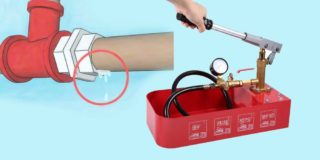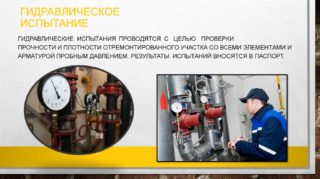Pressure testing of water supply networks is carried out in order to check their functionality and identify weak points. By eliminating all problems in a timely manner, you will ensure the operability of the pipeline and avoid serious breakdowns.
The need for hydraulic tests

The operation is performed on a small section of the line, which is isolated from the main line and subjected to a high pressure test, bordering on the critical one. A large volume of compressed air is pumped into the branch or a water flow is started under pressure. If the branch passes this test and maintains its tightness, it is recognized as fit for further exploitation. A breakthrough will be indicated by a pressure drop on the pressure gauge.
Hydraulic tests are necessarily subjected to:
- newly created highways;
- repaired networks;
- plastic pipelines after cleaning;
- pipe sections after replacing a damaged section or installing a coupling, tee;
- water pipes in the apartment after connecting the water meters;
- heating systems before the heating season.
Pressure testing of wells is carried out in order to check the absence of contact of the transported liquid with the upper layers of water in the mine. This is necessary to accurately determine the depth of the water intake.
Preparing for the procedure
Before testing, it is necessary to inspect the pipes for obvious defects and eliminate them. You will also need to remove the coolant from heating systems.
Further actions are as follows:
- Flushing the line to eliminate scale, corrosive and organic build-up.
- Assessment of the state of the inner surface of pipes.
- Installation of a non-return valve and a pressure gauge, if they come with pressure equipment.
A non-return valve is required to keep the process fluid in the network.
When preparing for the procedure, it is also important to choose the right pump. Low-power pressure equipment will increase the test time, which can lead to distorted results.
Units are manual and electric. The suitable one must be selected based on the volume of the tested highways.
To pressurize the water supply system in a small private house or apartment, a supercharger will be sufficient, pumping through itself a couple of liters per minute. Work on centralized water supply systems and heating mains involves the use of powerful circulation pumps. An automobile compressor can be used for air pressure testing.
The order of work
- Seal the section of the line to be tested. To do this, close the shut-off valves at the end and beginning of the section.
- Disconnect system elements that are not designed for test pressure - safety valves and other fittings, boiler, boiler, expansion tanks.
- Connect pressure equipment. The pump is connected to the hot or cold water tap. In heating networks - to the radiator faucet.
- Pump water or air through the check valve.
- Monitor the pressure with a pressure gauge. For cast iron pipes, it should be 1.5 atmospheres, for non-pressure plastic products - 1.5-2, for pressure - 10-15. When checking heating networks in private houses, 2 atmospheres is enough.
- Turn off the crimper and record the primary value on the measuring device and leave the system for 6-8 hours.
At the end of the control time, it is necessary to compare the initial indicator with the current result. If the first is lower, there is a problem in the water supply system.
If the line is tested with water flow, it is not difficult to detect leaks. During air pressure testing, all connecting nodes are coated with soapy water. Bubbles appear at the leak. After troubleshooting, testing is performed again.
SNiP and safety measures
Pressure testing of the pipeline with water or air is regulated by building codes:
- SNiP 3.05.01-85 is devoted to communication networks;
- SNiP 3.05.04-85 - for external highways;
- SNiP 41-01-2003 - operation of heating and ventilation systems.
These documents indicate the procedure for conducting hydraulic testing, the technological schemes of this process and safety rules are spelled out.
The most important thing is to control the pressure readings during testing. If they are excessive, the destruction of the parts of the line is possible. To insure against this, it is worth using a crimper with a special limiter.
Almost any intervention in water supply and heating systems implies that a pressure test will be carried out after that. It will allow you to identify all the weak points that cannot be visually found.









